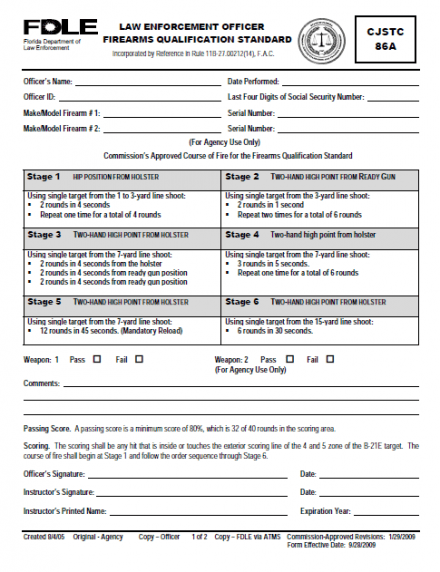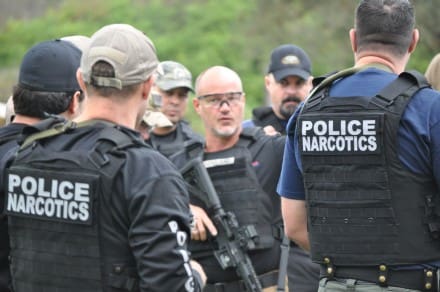Ken’s GFM was spot on about having easy standards that Ray Charles could pass. I don’t mean to pick on Florida because I know Boynton Beach PD, Hillsboro County & Polk County Sheriffs shoot well beyond the standard attached, but I don’t believe the standard is for them, rather than for the Sheriff or other busy decision makers that don’t have time to get to out the range.
I’ll raise the B/S flag on that one because I pay attention around the PDs and Sheriffs offices I train at. I see a Sheriff in Arkansas instructing civilians on his off time on top of being a political figure in the community. Most law enforcement agencies have gotten better about raising their level of training in recent years, but there are still those LEOs walking the streets that should be carrying a tazer instead of a firearm.
Check out the Florida standard I’ve attached and ask yourself, is it challenging?
Maybe with a tomahawk and a blind fold!
Respectfully,
Daryl Holland
Daryl Holland is a retired U.S. Army Sergeant Major with over 20 years of active duty experience, 17 of those years in Special Operations. Five years with the 1st Special Forces Group (SFG) and 12 years in the 1st SFOD-Delta serving as an Assaulter, Sniper, Team Leader, and OTC Instructor.
He has conducted several hundred combat missions in Afghanistan, Iraq, Bosnia, Philippines, and the Mexican Border. He has conducted combat missions in Afghanistan’s Hindu Kush Mountains as a Sniper and experienced Mountaineer to the streets of Baghdad as an Assault Team Leader.
He has a strong instructor background started as an OTC instructor and since retiring training law abiding civilians, Law Enforcement, U.S. Military, and foreign U.S. allied Special Operations personnel from around the world.
Gunfighter Moment is a weekly feature brought to you by Alias Training & Security Services. Each week Alias brings us a different Trainer and in turn, they offer some words of wisdom.




Don’t forget, the state Qual only needs to be shot annually in Florida.
I could not agree more that this standard is far too easy. I am a 20 year Florida LEO and active CJSTC Firearms Instructor. This standard is a joke but sadly, I have seen many current LEO unable to pass it on the first try. I have personally seen one fail to the point their gun was collected and they were placed on admin duty. Florida, like many other states, has a standard far too easy which is largely due to the amount of people who want to do this job because of the blue light effect but do not want to invest the time and effort to REALLY do this job. As an instructor at an agency of about 100 sworn, I have seen everyone qualify at one time or another. Sadly, there are only about 20 or so I would like to see with me during a gunfight. Even more sad is the fact that this is probably the average just about anywhere you go.
The standards are ridiculously easy. I’m retired and shoot the course for LEOSA.
You can through every round at the 15 yard line and still qualify.
On a side note, strangest thing I’ve seen at the range. An officer had the ammunition loaded backwards into a magazine.
Must’ve had an H&K.
The standards on form 86A were intended for compliance with HR 218 only. It was purposely designed for realistic LEO engagement ranges while being a reachable standard for retired LEOs.
That said, any agency using it as their sole qualification is approaching malfeasant.
This form indicates it is “Commision Approved.” I’m betting there were some issues inherent to that and the final standard.
Another Bill: our state’s is about as bad. It boils down to politics and money. Budgets are being cut all over, we can barely afford tires and fuel, let alone “training.” In a lot of agencies taking time to train means paying overtime, if you can get someone to cover shifts while someone else is in training. It’s also a lowest-common-denominator test, and we are specifically told, and our state won’t recognize, that qualifications do not count as training. They actually reduced the number of rounds shot in quals so that theoretically there would be more time and ammo for training, which resulted in absolutely nothing.
I’m not defending it, but there are a whole lot of factors involved. I’m also the agency’s training and qual guy and would love 40 to 80 hours per year per officer to put towards training, including stuff like report writing and driving. 4 hours is the required minimum, so in a lot of agencies that’s all they’ll get, and post-Ferguson/Baltimore it will be legislatively mandated to be “institutional racism,” “inherent bias (because we are all prejudiced, we just don’t know we are prejudiced)” or “restorative justice,” and not how write a comprehensive report, control a car in a skid or actually shoot a gun.
And yes, every training officer in the state has gone to their boss and told them that money not spent on training will be multiplied by a factor of 100 and paid out in civil settlements.
I get that Daryl’s point is “this is not what right looks like”. I retired from 20 years as a police officer and I spent a considerable amount of my time serving as a firearms instructor. The conventional wisdom is that better training equals better officers but that has not proven itself to be true especially when it comes to officer involved shootings. When I first became an instructor I used to look at the officers that I was teaching and pass mental judgements on their performance and level of commitment. I spent most of my free time shooting and most of my extra money on gear so I considered anyone who did less to lacking commitment. What I saw on the street changed my opinion because I personally witnessed a fellow officer who was terrible at firearms and barely passed qualification year after year shoot a guy three times in the heart while running and being shot at himself. Three rounds fired all in a fist size group in less than few seconds. Later I saw another officer who was gun guy and shot more than me get shot at and he hid behind a car and did not return fire while the rest of us killed the guy. He later decided law enforcement did not pay enough and moved onto other things. My point is that what you think is right is not always right. The old adage of “the size of the fight in the dog” is as true as ever.
Qualification is an administrative process and is not and should not be considered training.
Roy, thanks for sharing your experiences. I’ve heard of similar observations from other firearms instructors where skill on the square range didn’t accurately predict how well someone did in a lethal force encounter.
My question to you is, what was different between the guy who did well in the OIS opposed to the guy who hid behind a car (besides skill on the range)? What allowed one to do better, and in retrospect, was there a way to predict that?
I dont know if you can predict but it has always seemed to me that the guys talking the most before battle do the least in battle. But that being said everyone one has good and bad days and every fight is different.
I know we only shoot to the 15 yard. When I first went to the academy it was 25 yard, but that got changed. The qualifications were changed to “more accurately reflect real life situations” however I think it has more to deal with office politics and trying pinch pennies. An easier qual means spending less money and time at the range. And heck we’ll go short handed before we dole out OT for training.
“When I first went to the academy it was 25 yard, but that got changed.”
I believe a big reason is that many officers were shooting poorly at 25 yards, yet still qualifying (by front loading their scores). Plus, accuracy in the field at that distance is dangerously abysmal to begin with. As such, departments began to wonder about the downsides of a de facto policy authorizing the use of deadly force at distances at which (a) most officers were not proven incompetent to attempt, and (b) few threats are likely to be sufficiently immediate.
My mom can pass this with flying colors and I don’t think she is strong enough to rack the slide.
When money was tight at our SO, I had to beg for months for us to even do one qualification. When we finally went to the range, my target had a bunch of extra hits come scoring time. Turns out, my sergeant, shooting two positions over, was such a bad shot that they were landing hits on my target! Innocent bystanders beware!
The training is where Officers learn, the qualification course involves no learning at all.
I am much more concerned about the quality of training my brothers and sisters receive, than a simple qual course of fire they will do over and over during their career.
I guess I must be the really old guy here. When I came on board with my career, POST in my state required a stage of 6 rnds kneeling, 6 rnds standing, and 6 rnds prone from the 50 yard line. Those were wheel gun days for the most part, and we had the choice between a 6 in or 4 in revolver (I carried a 6 in Python at the time) in what ever caliber between .38, and .45 you wished (later carried a SW Mod 24 and 25). When we transitioned to auto’s at mid career, less and less officers could qual at the 50, so they moved all the stages to 25 and closer. Now, it seems as if 25 yards is starting to be the maximum, and I have seen POST courses that only required 2 rnds from the 25 yard line. I understand that the majority of officer involved gunfights are at the up close and personal range, but if you look at some shootings here in the last 2-5 years, there have been quite a few that have happened beyond 35 yards or so. I always figured it was good to be able to hit at that range, or at least have some knowledge of your sight index “way out there”, because you just never know do ya’.